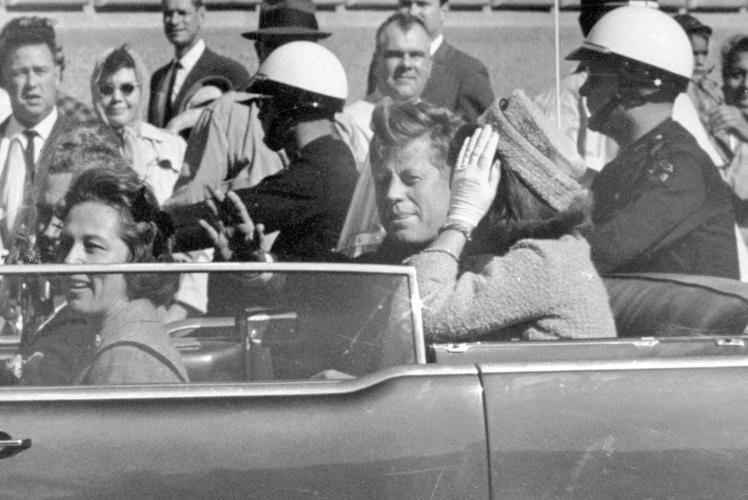Millions of documents related to the 1963 assassination of President John F. Kennedy in Dallas already were made public, but President Donald Trump ordered the release of thousands of still-classified files.
He signed the executive order Jan. 23 among a flurry of others in the first week of his second term.
Many people who studied what was released so far say the public shouldn't anticipate any earth-shattering revelations, but there is still intense interest in details related to the assassination and the events surrounding it. And the possibility of significant new information is tantalizing to researchers.

President Donald Trump holds a signed an executive order Jan. 23 regarding the declassification and release of records relating to the assassinations of former President John F. Kennedy, Sen. Robert F. Kennedy and Rev. Martin Luther King Jr. in the Oval Office of the White House in Washington.
Trump's order
The order directed the national intelligence director and attorney general to develop a plan within 15 days to release the records related to Kennedy's assassination. It's not clear when the records might actually be made public.
People are also reading…
The order also aims to declassify remaining federal records related to the 1968 assassinations of Sen. Robert F. Kennedy and the Rev. Martin Luther King Jr. It says a plan must be developed within 45 days for the release of those files.

The Rev. Martin Luther King Jr. speaks to reporters May 9, 1963, in Birmingham, Ala.
After signing the order, Trump handed the pen to an aide and directed that it be given to Robert F. Kennedy Jr., whom Trump nominated to be the health secretary. He's the nephew of John F. Kennedy and son of Robert F. Kennedy.
Robert F. Kennedy Jr., whose anti-vaccine activism alienated him from much of his family, said he isn't convinced that a lone gunman was solely responsible for his uncle's killing. He thanked Trump for ordering the release of the files and "trusting American citizens."

Sen. Robert F. Kennedy, D-N.Y., speaks in Washington, March 16, 1968, as he announces he will run for president.
Nov. 22, 1963
When Air Force One carrying JFK and first lady Jacqueline Kennedy touched down in Dallas, they were greeted by a clear sky and enthusiastic crowds. With a reelection campaign on the horizon the next year, they went to Texas for a political fence-mending trip.
As the motorcade was finishing its parade route downtown, shots rang out from the Texas School Book Depository building. Police arrested Lee Harvey Oswald, 24, who positioned himself from a sniper's perch on the sixth floor. Two days later, nightclub owner Jack Ruby fatally shot Oswald during a jail transfer.
A year after the assassination, the Warren Commission, which President Lyndon B. Johnson established to investigate, concluded that Oswald acted alone and there was no evidence of a conspiracy.
Still, that didn't quell a web of alternative theories over the decades.

President John F. Kennedy waves from his car Nov. 22, 1963, in a motorcade in Dallas with first lady Jacqueline Kennedy, right, Nellie Connally, second from left, and her husband, Texas Gov. John Connally, far left.
The JFK files
In the early 1990s, the federal government mandated that all assassination-related documents be housed in a single collection in the National Archives and Records Administration. The collection of over 5 million records was required to be opened by 2017, barring any exemptions designated by the president.
Trump, who took office for his first term in 2017, said he would allow the release of all remaining records but ended up holding some back because of what he called the potential harm to national security. While files continued to be released during President Joe Biden's administration, some remain unseen.
Larry J. Sabato, director of the University of Virginia Center for Politics and author of "The Kennedy Half-Century," said that most researchers agree that roughly 3,000 records have not yet been released, either in whole or in part, and many of those originated with the CIA.
There are still some documents in the JFK collection that researchers don't believe the president will be able to release. About 500 documents, including tax returns, weren't subject to the 2017 disclosure requirement.
What's been learned
Some of the documents already released offered details on the way intelligence services operated at the time, including CIA cables and memos discussing visits by Oswald to the Soviet and Cuban embassies during a trip to Mexico City just weeks before the assassination. The former Marine previously defected to the Soviet Union before returning home to Texas.
One CIA memo describes how Oswald phoned the Soviet embassy while in Mexico City to ask for a visa to visit the Soviet Union. He also visited the Cuban embassy, apparently interested in a travel visa that would permit him to visit Cuba and wait there for a Soviet visa. On Oct. 3, more than a month before the assassination, he drove back into the United States through a crossing point at the Texas border.
Another memo, dated the day after Kennedy's assassination, says that according to an intercepted phone call in Mexico City, Oswald communicated with a KGB officer while at the Soviet embassy that September.
The releases also contributed to the understanding of that time period during the Cold War, researchers said.



















